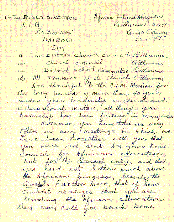
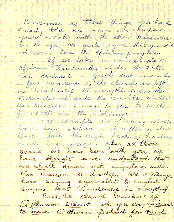
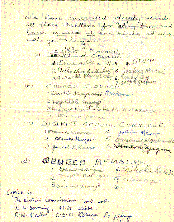
(The documents and images featured here are for the personal use of students, scholars and the public. Any commercial use or publication of them is strictly prohibited.)
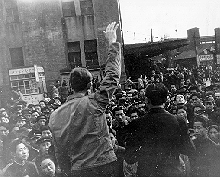 The transition from missionary to national authority usually involves a process
of instruction and practical training, increasing oversight by indigenous
Christians, and subsequent involvement of missionaries in locally developed plans
and programs.
The transition from missionary to national authority usually involves a process
of instruction and practical training, increasing oversight by indigenous
Christians, and subsequent involvement of missionaries in locally developed plans
and programs.
Before national evangelists were trained, Western
missionaries would address groups of people themselves. In this photograph,
Leonard Sweet, Far Eastern Gospel Crusade missionary, presents an
evangelistic message to a Japanese crowd on a street corner, accompanied
to his right, probably by an interpreter or a trainee. 1950s. The photograph is
part of
Collection 406, the Records of SEND International, which you can examine
to explore the description of these administrative records further.
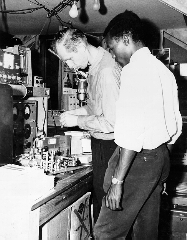 Training was a critical element in transferring responsibility for any aspect of
the ministry to national personnel. Electronic engineers (depicted to the right)
work together at one of the Africa Inland Mission's radio stations. Ca. 1968.
From
Collection 81, the Records of Africa Inland Mission.)
Training was a critical element in transferring responsibility for any aspect of
the ministry to national personnel. Electronic engineers (depicted to the right)
work together at one of the Africa Inland Mission's radio stations. Ca. 1968.
From
Collection 81, the Records of Africa Inland Mission.)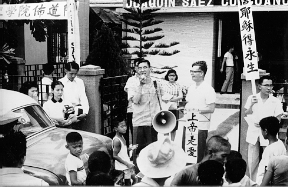
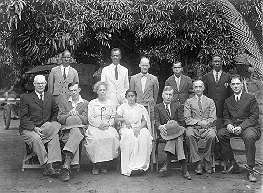 The theoretical goal in most mission efforts is to sooner or later transfer the work
to indigenous Christians. How that goal is achieved, the speed at which it is
implemented, and the readiness which it produces varies widely. The
photograph at left documents one important milestone in the life of the
emerging Tanganyikan church. Dedication and ordination at Mwanza,
Tanganyika, of the four African pastors in the Africa Inland Church. Standing
in back from left to right: Tomaso Nhela, Isaka Nyalagu, Mr. Jester (a
missionary), Mr. Vargughese (a local Indian Christian), and Yakobo Mhoia.
The fourth pastor ordained, Yonazani Malongo, was not present for this
picture. The people in the front row are all either AIM workers or local
Christians. 1932.
From Collection 81, the records of Africa Inland Mission.
The theoretical goal in most mission efforts is to sooner or later transfer the work
to indigenous Christians. How that goal is achieved, the speed at which it is
implemented, and the readiness which it produces varies widely. The
photograph at left documents one important milestone in the life of the
emerging Tanganyikan church. Dedication and ordination at Mwanza,
Tanganyika, of the four African pastors in the Africa Inland Church. Standing
in back from left to right: Tomaso Nhela, Isaka Nyalagu, Mr. Jester (a
missionary), Mr. Vargughese (a local Indian Christian), and Yakobo Mhoia.
The fourth pastor ordained, Yonazani Malongo, was not present for this
picture. The people in the front row are all either AIM workers or local
Christians. 1932.
From Collection 81, the records of Africa Inland Mission.
Field Director of the Africa Inland Mission from some of the Africa Inland Church
leaders of Githumu, Kenya, criticizing the mission for what they called its
over-emphasis on evangelism at the expense of education and asking the
mission to leave the area. This petition was part of a larger dispute between
the mission and the church and between and within tribes in the Githumu
area. Eventually it was arbitrated in court, with some of the mission property in
the area going to the dissident segment of the church. November 25, 1947.
From Collection 81, the records of Africa Inland Mission.
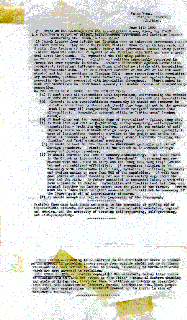 At other times, the government set the transition agenda by dictating policy,
as was the case in China. The depicted notes were compiled by missionary
Kenneth MacGillvray, based on reports he heard about a 1950 meeting in Sian,
China (now Xian), between Chou En-lai and other Communist government leaders
and Chinese pastors from Peking and Tientsin. At this meeting, the
Communists outlined the policy the churches would be required to follow of
being independent of foreign missionaries, self-supporting, and accepting of the
government's leadership. This was the beginning of what became known as
the Three-Self Church. June 11, 1950.
From Collection 341, the papers of Victor Plymire. To view an enlarged image of
MacGillvray's notes, click on the image to the left. To read a full-text transcript of the
notes, click here.
At other times, the government set the transition agenda by dictating policy,
as was the case in China. The depicted notes were compiled by missionary
Kenneth MacGillvray, based on reports he heard about a 1950 meeting in Sian,
China (now Xian), between Chou En-lai and other Communist government leaders
and Chinese pastors from Peking and Tientsin. At this meeting, the
Communists outlined the policy the churches would be required to follow of
being independent of foreign missionaries, self-supporting, and accepting of the
government's leadership. This was the beginning of what became known as
the Three-Self Church. June 11, 1950.
From Collection 341, the papers of Victor Plymire. To view an enlarged image of
MacGillvray's notes, click on the image to the left. To read a full-text transcript of the
notes, click here.
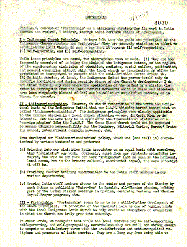 In other cases, transition wasn't required from the outside but instead
planned and then implemented by those directly involved. In the first page of this November 6, 1958,
"Partnership"memo from W. Dayton Roberts, one of Latin America Mission's
executives, he outlines the mission's three-stage strategy for eventually turning over
control for most of its activities to indigenous church leaders:
In other cases, transition wasn't required from the outside but instead
planned and then implemented by those directly involved. In the first page of this November 6, 1958,
"Partnership"memo from W. Dayton Roberts, one of Latin America Mission's
executives, he outlines the mission's three-stage strategy for eventually turning over
control for most of its activities to indigenous church leaders:
The two-page memo which follows below summarizes the views of Mexican
Juan Isais, also of the LAM staff, on what should be the relations between the
mission and the AIBC (Asociacion de Iglesias Biblicas Costarricenes or, in
English, the Association of Costa Rican Bible Churches). Ca. 1960. Both the
Roberts and Isais memos are part of
Collection 236, the records of the Latin America Mission.
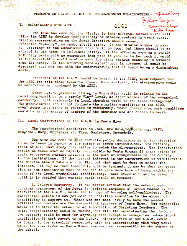
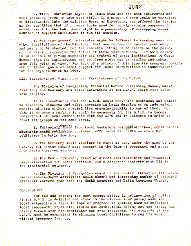
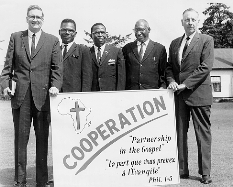 Cooperation between missions and churches was essential not only for a smooth
and effective transition, but the continuing development of the Christian faith.
Shown here is the executive committee of the Association
of Evangelicals in Africa and Madagascar, an association of churches, missions
and other Christian organizations formed in 1966. From left to right, Dr. Terry
Hulbert (vice-president), Rev. Marc Massembo (secretary), Rev. David Olatayo
(president), Andrew Gichuha (treasurer), Rev. Kenneth L. Downing (secretary).
1966.
From Collection 81, the records of Africa Inland Mission.
Cooperation between missions and churches was essential not only for a smooth
and effective transition, but the continuing development of the Christian faith.
Shown here is the executive committee of the Association
of Evangelicals in Africa and Madagascar, an association of churches, missions
and other Christian organizations formed in 1966. From left to right, Dr. Terry
Hulbert (vice-president), Rev. Marc Massembo (secretary), Rev. David Olatayo
(president), Andrew Gichuha (treasurer), Rev. Kenneth L. Downing (secretary).
1966.
From Collection 81, the records of Africa Inland Mission.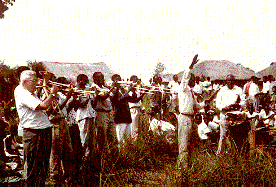 With indigenous leaders assuming responsibilities, missionaries moved on to
new assignments, were given assignments by the national church, or fit in where
needed. In this evangelistic service in a village in the north east section of what
was then the Congo, Austin Paul, the man on the far left playing the marching
French horn, contributed to the musical presentation. Paul, an Africa Inland
Mission worker, taught the other brass players. Ca. 1967.
From Collection 81, the records of Africa Inland Mission.
With indigenous leaders assuming responsibilities, missionaries moved on to
new assignments, were given assignments by the national church, or fit in where
needed. In this evangelistic service in a village in the north east section of what
was then the Congo, Austin Paul, the man on the far left playing the marching
French horn, contributed to the musical presentation. Paul, an Africa Inland
Mission worker, taught the other brass players. Ca. 1967.
From Collection 81, the records of Africa Inland Mission.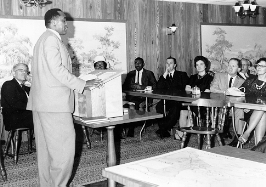 The relationship between a mission and the churches it helped start is not only
complex but continuing. Here is one image of the continuing and evolving contact:
Timothy Kamau, director of the radio department of Africa Inland Mission
in Kenya, addressing a luncheon of mission supporters in Grand Rapids, Michigan.
He was in the United States to attend the Congress on the Church's World Wide
Mission in Wheaton. 1966.
From Collection 81, the records of Africa Inland Mission.
The relationship between a mission and the churches it helped start is not only
complex but continuing. Here is one image of the continuing and evolving contact:
Timothy Kamau, director of the radio department of Africa Inland Mission
in Kenya, addressing a luncheon of mission supporters in Grand Rapids, Michigan.
He was in the United States to attend the Congress on the Church's World Wide
Mission in Wheaton. 1966.
From Collection 81, the records of Africa Inland Mission.